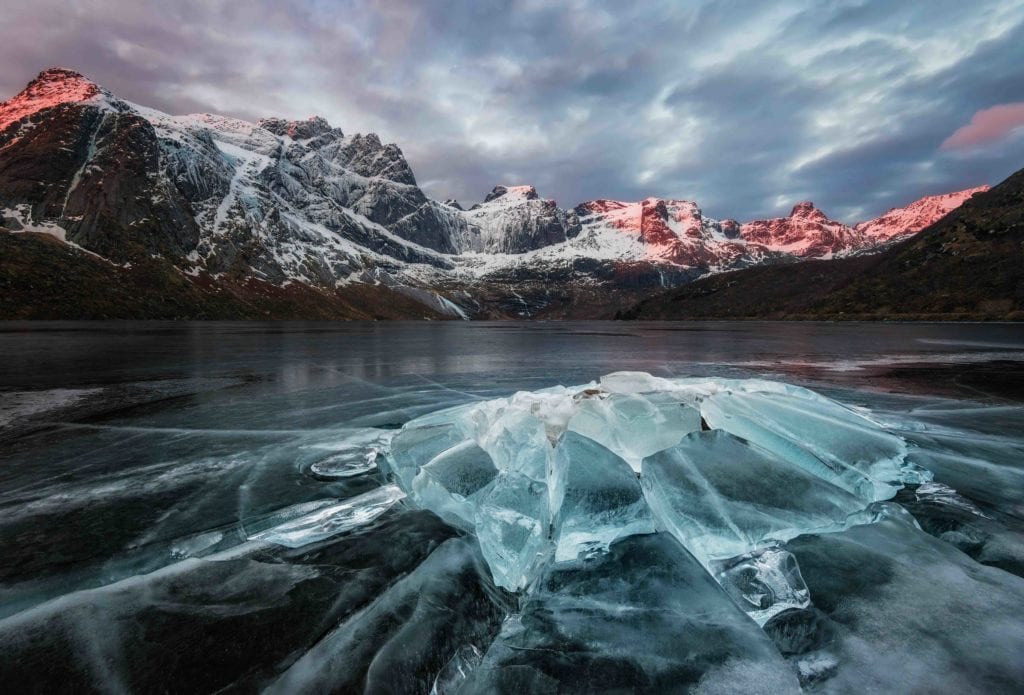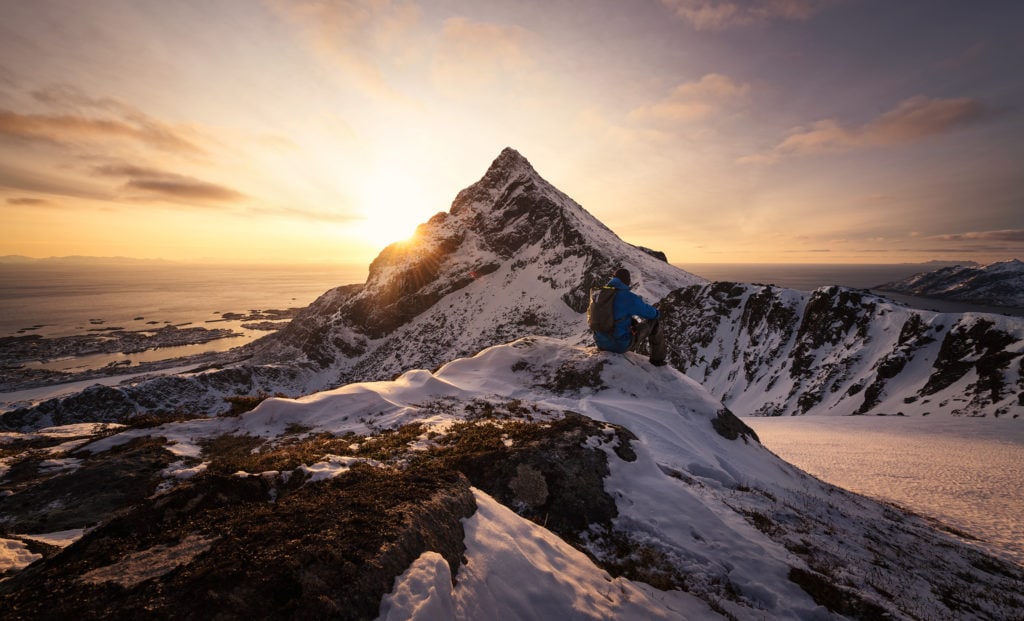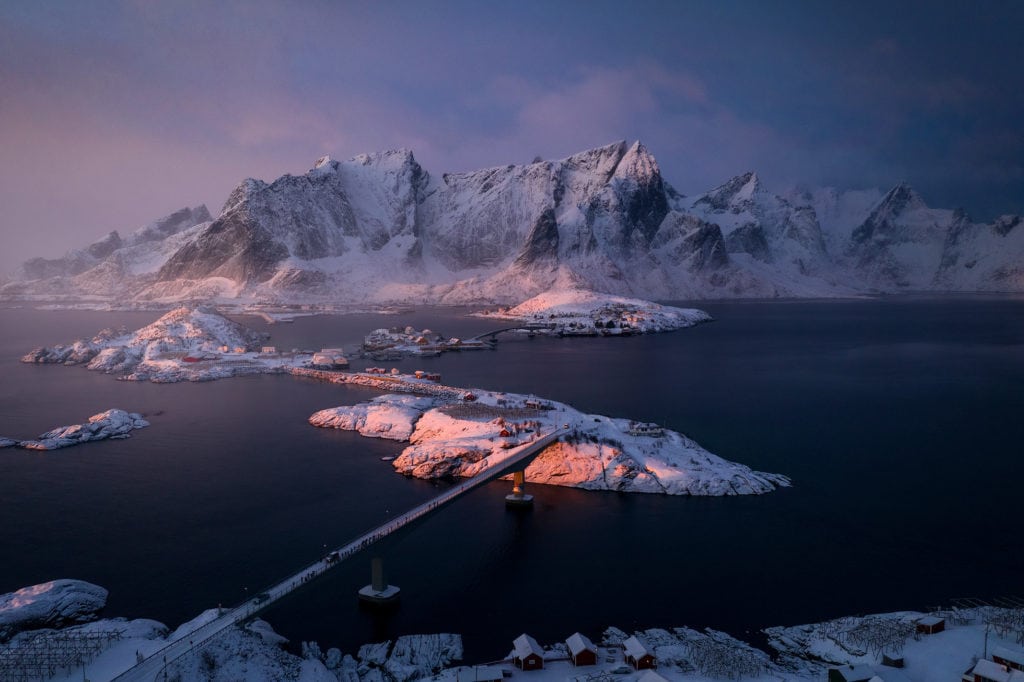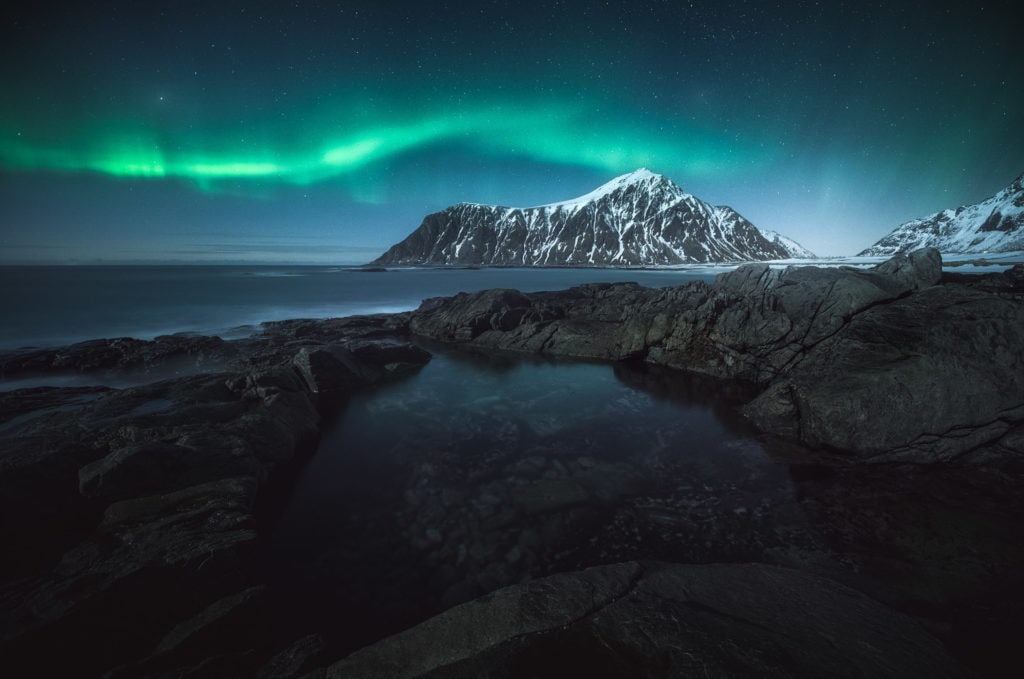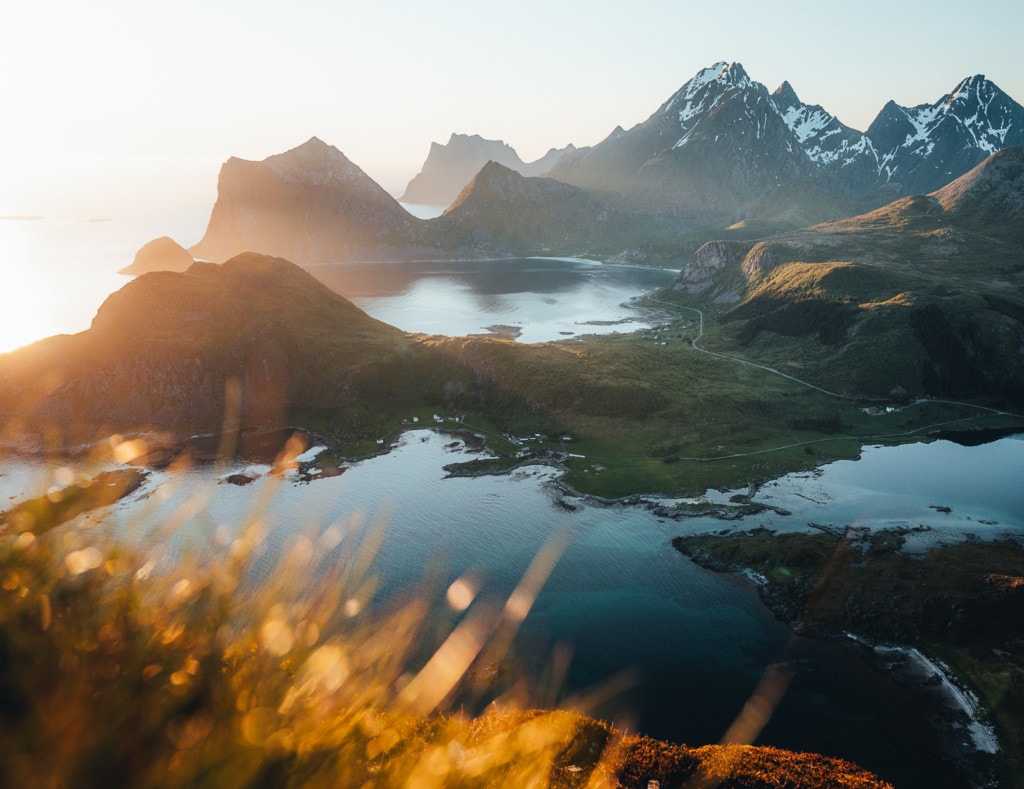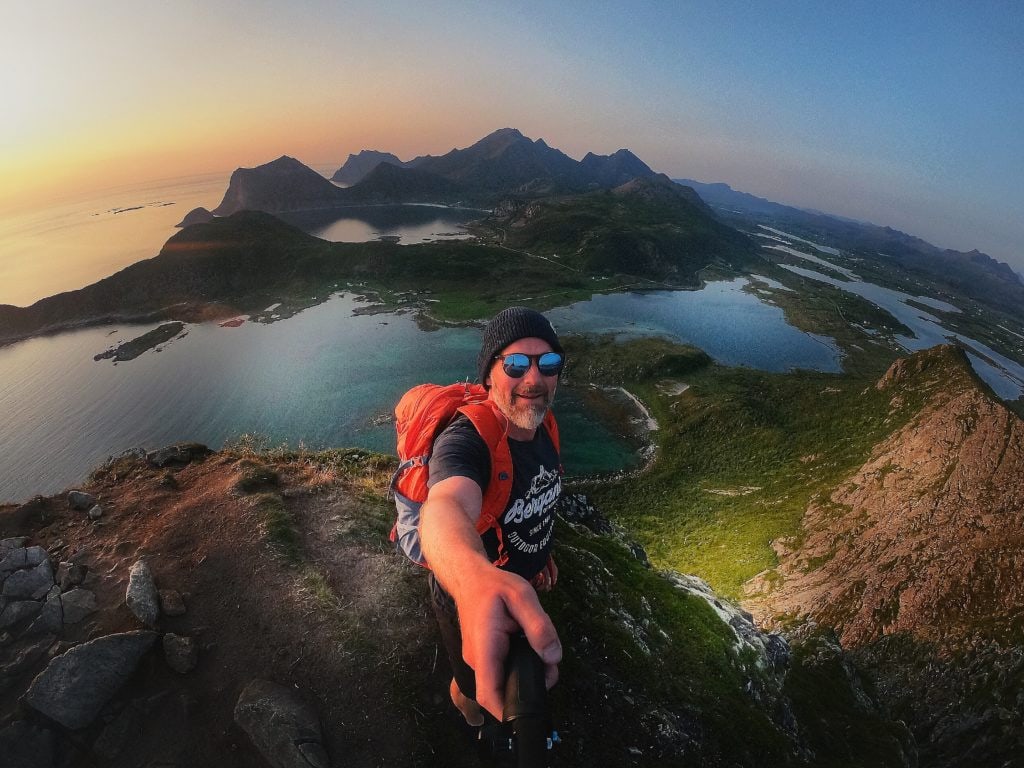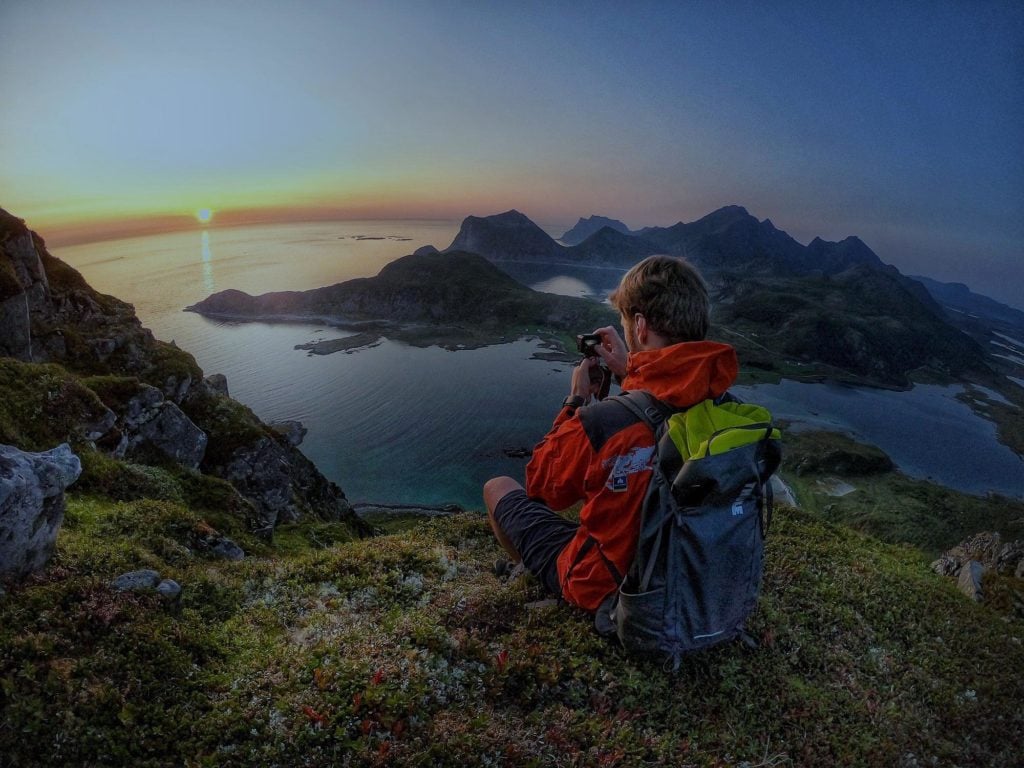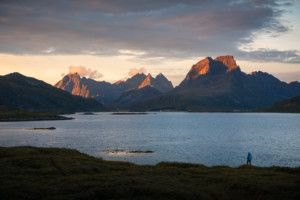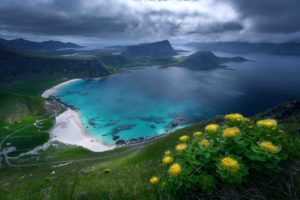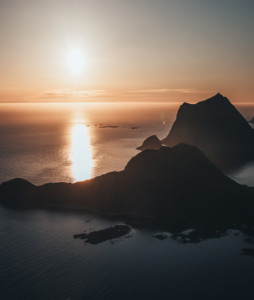Imagine that there’s a land where the sun doesn’t set in summer but doesn’t rise in winter. A place where the night sky explodes into a colorful dance and jagged mountains rise up from the ocean. Such a place sound like taken from a fairytale or a Disney movie but in reality, it’s named the Lofoten Islands.
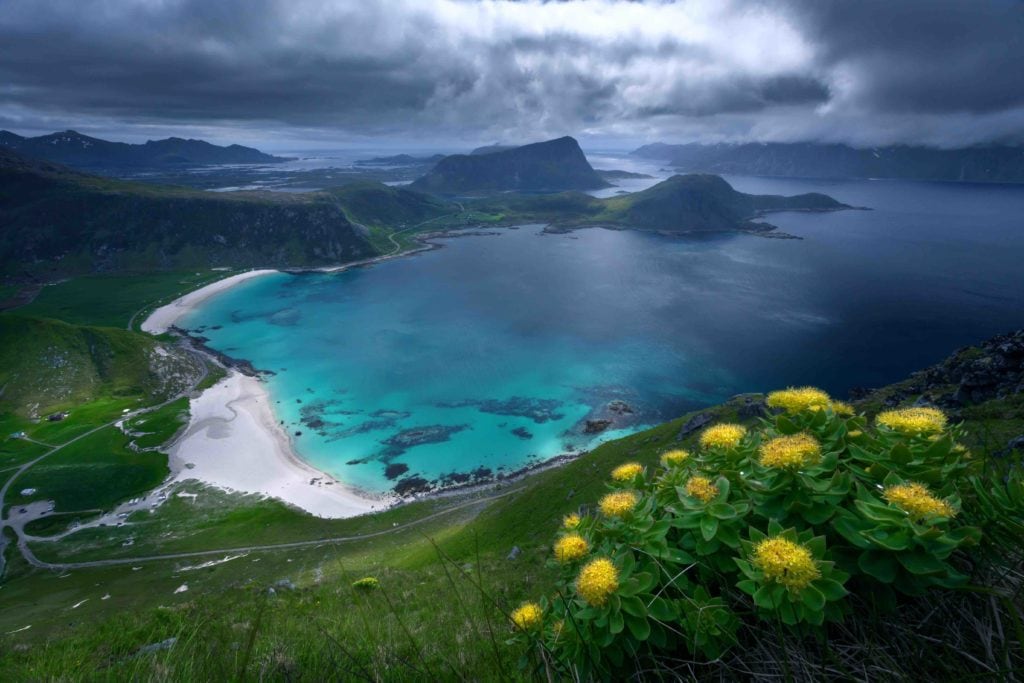
It’s not without a reason that this is considered one of the most stunning regions in the world and it’s not without a reason that adventurous from all around the world have it on their bucket list.
The winters are long and the summers are mild but the adventures and experiences found here will last a life time. Each season in Lofoten holds new opportunities. The adventure awaits.
You might be asking ‘when is the best time to visit?’ Let’s take a closer look at the seasons in Lofoten and what to expect from them.
Winter in Lofoten
Polar Nights, Northern Lights, snow-covered peaks, cod fishing and storms. These are just a few keywords that describe the winter in Lofoten. Those who dare to brave the at times cold and stormy weather will be treated with some of the most incredible sights our planet has to offer.
Winter in Lofoten begins in November and lasts throughout March. The months are dark and often stormy but it’s also a time when the islands turn into a winter wonderland; peaks covered in fresh snow, a blue sunny sky and a silence that removes all stress.
When the sun sets and the night sky take over, the presence of the Northern Lights makes this fairytale-like landscape even more spectacular.
With temperatures averaging around 0 degrees Celsius (though days up to +5 and down to -10 can be expected), the Lofoten winter isn’t nearly as cold as other places in Norway. However, strong winds make it feel colder so it’s important to bring enough warm clothes.
During the coldest and stormiest days, it’s extra nice to come back to a warm and cozy cabin, and perhaps even enjoy a visit to the sauna or hot tub.
November and December tend to be wet and the unstable weather system leads to an abundance of ‘bad-weather’ days. December is darkest month of the year and marks the beginning of the Polar Nights, a period where the sun doesn’t rise above the horizon. The Polar Nights lasts from the 9th of December until January 4th.
The weather becomes somewhat more stable in January. As the sun slowly makes it way back above the horizon, the Lofoten archipelago beautifully shines in the atmospheric blue Arctic light. The sunrise and sunset blends together and results into a colorful show that lasts for several hours. It’s not uncommon to have a beautiful red sky last for a solid 5 hours!
The never-ending makes winter the most popular season for photographers and the images they capture are stunning. This lasts well into February and as we’re moving into March, the days are quickly getting longer.
March provides longer days and a more stable weather. Storms can still be expected at the end of winter but the long days makes this a great time to plan a more active stay for those interested in exploring the mountains with a pair of skis or snowshoes.
Winter is also high season for fishing. In fact, it’s one of the world’s largest fisheries. Fishermen from all over Norway come to the Lofoten Islands to try their luck. With the Arctic cod spawning in the Lofoten area, this easily one of the world’s best locations for fishing.
Best of all? It’s perfectly possible for you to join a fishing boat to try your own luck!
Let’s take a look at some of the highlights when visiting the Lofoten Islands in winter:
- The dark days makes for great opportunities to see the Northern Lights
- The mountains covered in snow transforms the islands into a true winter wonderland
- From December 9th to January 4th the sun doesn’t rise above the horizon
- The picturesque Arctic during the return of the sun attracts visitors from all around the world
- The end of winter is the perfect time to plan an active stay to explore the abundance of mountains
- The famous Lofoten fishing takes place from mid-February to early April
Spring in Lofoten
Most think of spring as a colorful season with blooming flowers, lush green trees and sweaters being replaced with t-shirts. Spring in Lofoten isn’t quite like that (don’t pack away the down jacket quite yet!)
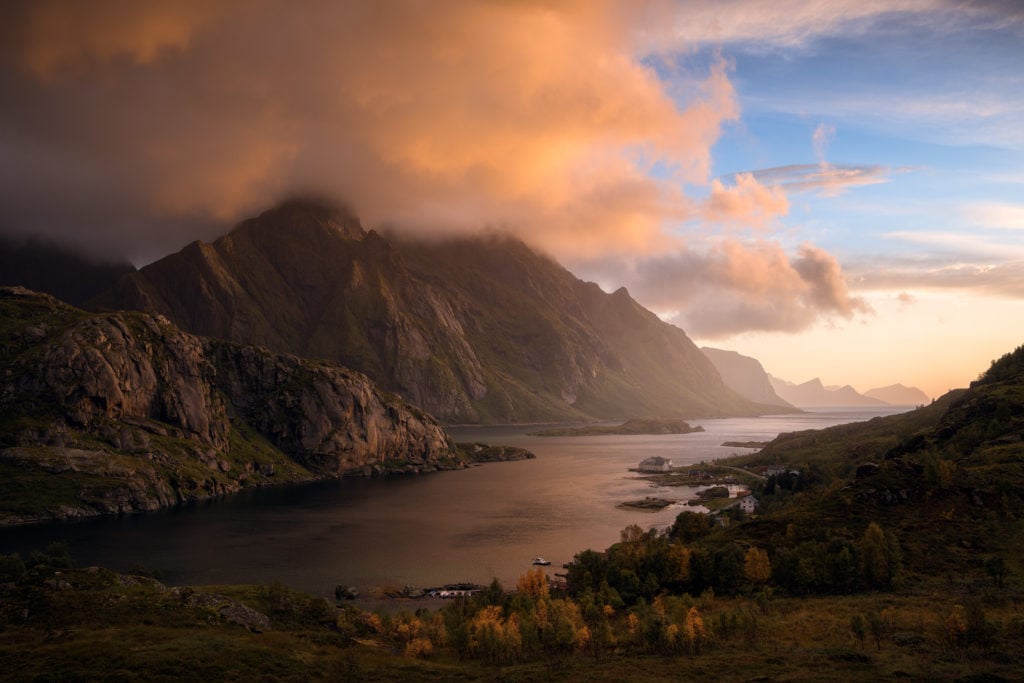
Days are still chilled and it’s not uncommon to have periodical snowfall until late May. With the midnight sun quickly approaching, however, the fresh snow rarely stays in the lower regions.
The locals have become experts in enjoying these sunny and take advantage of them by going for a walk on the beach, around a lake or by going out on a boat ride. There are few things more beautiful than walking along a sandy beach with crystal clear water and surrounded by spiky mountains that still have a layer of snow on top.
Early spring in Lofoten is a great period to plan an active stay as it’s a great time for skiing. The higher mountains still have plenty of snow and there are endless of lines waiting for you. There are few places that have better views and, if weather allows, you might even be able to ski under the midnight sun!
Be careful, though, the changing weather increases the avalanche and rockslide danger so make sure to stay updated on official sites such as varsom.no
Snow typically remains in the inland mountains until the end of June or early July but in the lower coastal areas hiking trails are becoming walkable much earlier. Since spring is still considered low season in the Lofoten Islands, it’s possible to enjoy some of the more popular hikes completely alone.
Here are some of the highlights of visiting the Lofoten Islands in spring:
- Days are becoming longer and the midnight sun returns approx. the 27th of May
- Hiking is good in the lower coastal mountains
- Skiing is good in the higher mountains
- Weather is improving and some days gives you a taste of summer
- Early spring is the last chance of seeing the Aurora until autumn
- Weather can still be unstable but days are getting brighter
Summer in Lofoten
It’s not without a reason that the summer season is the busiest season in the Lofoten Islands; this is a good time to visit for either a relaxing vacation or an active stay. The summer months have a lot to offer for everyone.
Another fascinating natural event takes place in the summer months: the midnight sun is visible from approximately the 27th of May until the 17th of July.
The sun doesn’t set below the horizon in this period, which results in 24 hours of daylight. This might take some time to adapt to as our brains get confused by the constant brightness but it’s an unforgettable experience. The sun is at its lowest around 2AM but it’s still far above the horizon. Make sure to drive to one of the sandy beaches or hike up a mountain to get a front seat view!
A benefit of the midnight sun for those planning an active stay in Lofoten is that the day never ends. This means there’s no need to worry about staying out too late in the mountains and you don’t need to pack a headlamp; hiking at midnight is just like hiking during an evening anywhere else in the world. Time quickly loses meaning during this time of year.
Most the snow has melted from the higher mountains so there are now endless of hiking opportunities of all difficulties. Most mountain hikes are doable as day-hikes and many have a breathtaking view after only a short (but steep) hike.
Summer is also a popular season for other activities such as trail running, mountain biking and kayaking. Imagine sitting in a kayak surrounded by large mountains, listening to the birds sing and feeling the sun gently lick your skin. That’s what summer in Lofoten is all about!
The summer months aren’t just for those wanting an active stay; there are just as many things to experience for those simply wanting to relax with the world’s most beautiful surroundings. Some recommendations are to pack a picnic bag and head to one of the scenic beaches for a midnight snack, take a tour of the Lofoten Islands by boat, visit one of the unique museums or take a drive and explore some of the historic villages.
Here are some highlights of summer in Lofoten:
- The midnight sun results in 24 hours of daylight
- Snow has melted and there’s an abundance of amazing hiking opportunities
- Rent a kayak and explore the archipelago from a different perspective
- Go for a stroll on a beach and enjoy the sun
Autumn in Lofoten
As the midnight sun comes to an end and the days gradually become darker, the autumn is coming back to the Lofoten Islands. The lush green colors are turning fiery red and the landscape quickly turns more dramatic-looking.
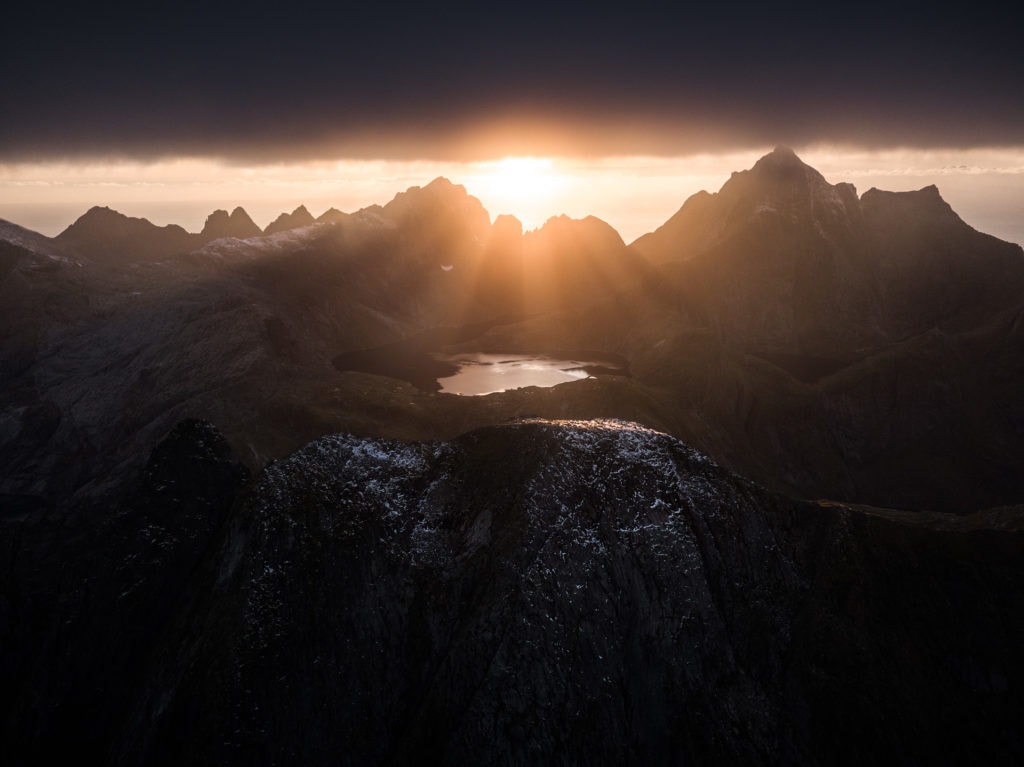
Autumn days are noticeably colder and the unstable weather is quickly returning, making it one of the wetter periods of the year. Despite this, it’s also a magical time.
The snow isn’t expected to arrive in the higher mountains until the end of autumn so this is still a great time to explore the mountains from both above and below. The shorter days and more ‘normal’ sunrises/sunset hours cast a beautiful golden glow upon the landscape.
Shorter days also mean darker nights and a return of the Northern Lights. Due to the higher temperatures, this is a more comfortable season to watch them than winter; on a good night you might not even need to wear two extra layers!
Hike up to one of the many mountains and get a unique experience watching the sky dance above the surrounding landscape. This is a once in a lifetime experience that stays with you forever.
Here are some of the highlights of autumn in Lofoten:
- The Northern Lights return in September
- Hiking is excellent – go up an easy mountain at night to get a unique perspective of the Aurora
- With the changing colors, the landscape looks more dramatic than during summer
- Temperatures are colder but good days are still comfortable compared to winter
Conclusion
The Lofoten Islands are the perfect destination for anyone who enjoys nature and beautiful sceneries. Either the purpose of the visit is to relax and enjoy, to climb a mountain, kayak in-between the fjords or photograph the scenery; the archipelago is waiting for you.
Each season is unique and has different highlights to offer:
Winter is the most popular season for photographers and the best time to chase the Northern Lights. It’s also a good time to join a fishing trip and experience the legendary Lofoten fishery.
Spring is a beautiful season where days are getting warmer and more comfortable. Hiking trails are becoming available and the landscape is turning back to life. Skiing is great in the higher mountains with endless of opportunities.
Summer is the most touristic season and offers all type of activities for everyone. The midnight sun leads to 24 hours of sunlight, which is an unique experience that’s best enjoyed from the top of a mountain or on a sandy beach.
Autumn is the season where the landscape turns dramatic and the weather is turning. The Northern Lights return in September and since the snow hasn’t arrived yet, it’s a unique chance to view them from the top of a mountain.

